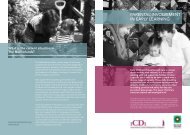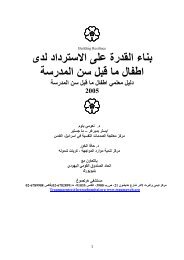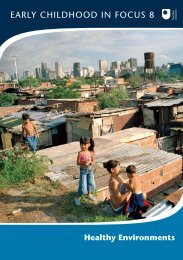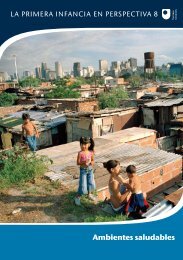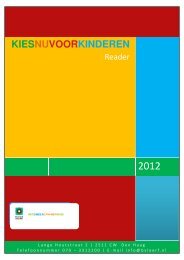Report - Bernard van Leer Foundation
Report - Bernard van Leer Foundation
Report - Bernard van Leer Foundation
You also want an ePaper? Increase the reach of your titles
YUMPU automatically turns print PDFs into web optimized ePapers that Google loves.
UNICEF have indicated, ‘… it is not enough just to decree that all children should be sent to schoolat the age of seven, unless there is also a concerted campaign to improve the nutritional status ofchildren from an early age. 15b. There is a high demand, and urgent need for community-based child-care support‘The women have no alternative for child care. When they look after children they can’t work,therefore, no food and less income; when they work, they can’t look after children. It is the childrenwho suffer as the women try to do both.’ – Male Elder, Mtwara Rural. 16c. Only 3% of pre-school age children access such services 17d. The number of HIV/AIDS affected young children is rapidly increasing, with no concrete supportreadily available. UNICEF has indicated that ‘…of the approximately 2 million orphans, 97 percent… are living with their extended families, many of them in seriously deprived circumstances. 18 Insome communities the number of children orphaned is as high as 40% and the proportion of childrenin school who have been orphaned has reached 50%. 19 Whilst there is some support for school-ageorphans, as one community member from Moshi rural has expressed, in Tanzania it seems that, Anorphan is only an orp han when they reach Standard One. 203. Contributing factors to infants and young children’s poor status.Table 2: Factors Contributing to the Poor Status of Infants & Young ChildrenSource: Towards Tanzania’s ECD EFA Action Plan, 2003 – 2015, Tanzania EC D Network, 20021. Poverty impacts on the lives of more than 50% of Tanzania’s population. Combined with a number ofsocio-cultural factors, the capacity of many poor families to adequately care for and nurture theirchildren is increasingly limited.2. The low status of women combined with their heavy workloads, negatively impacts on the quality ofcare of infants and young children.‘The root cause of maternal deaths and morbidity in Tanzania are directly related to women’s lowsocio-economic statues and their limited access to quality social services. In the current situation,complications during pregnancy and birth lead to illness and disabilities – and have graveconsequences for women’s lives and survival as well as that of their children. 21i. significant gender inequalities prevail, and women often are excluded from decision-makingespecially related to family resources control and inheritance issues;ii.iii.women carry the bulk of the responsibility for child-care, whilst their work loads appear to beincreasing;women (and youth) provide most of the labour force in rural areas, they have very limited accessto land – as land tenure which is a male issue , and their participation in family allocation of fundsand community decision -making is negligible. It is estimated that in many villages women form lessthan 10% of representation in village governments. 22iv. with the break-down of families, it is estimated that approximately 13% of rural households areheaded by women, which, on average, are poorer ..’ 23v. women’s standard of education is low – 57.1%literacy rate compared to 70.6 % for men. 2415 UNICEF, Tanzania, 1995, The Girl Child in Tanzania16 AMANI ECCD, 2001,17 Government of the United Republic of Tanzania, Basic Education Master Plan, 200018 Government of United Republic of Tanzania & UNICEF, 2001, Situation Analysis of Children in Tanzania.19 Government of United Republic of Tanzania & UNICEF, 2001, Situation Analysis of Children in Tanzania.20 AMNANI ECCD, 200121 Government of United Republic of Tanzania & UNICEF, 2001, Country Programme of Co-operation for 2002 – 2006, Draft document,Version 01.04.01ECD sub-project 1.3.22 United Republic of Tanzania & UNICEF, 2001, Country Programme of Co-operation for 2002 – 2006, Draft document.23 UNDP 2000, Tanzania Human Development <strong>Report</strong> 1999, p.424 UNDP, 2001, United Nations Development Assistance Framework for Tanzania, p.138




